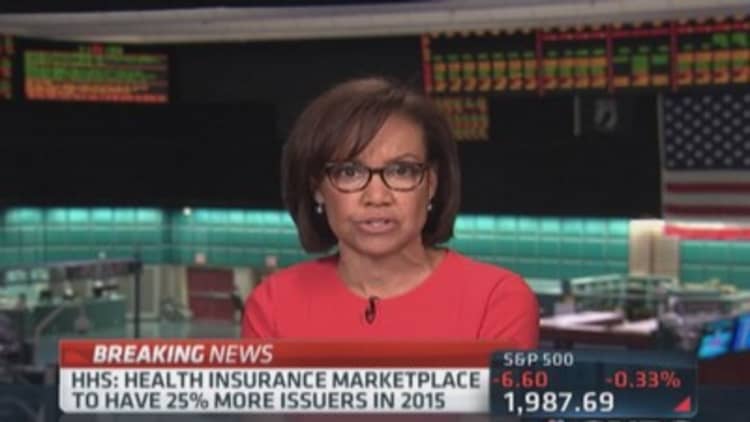The Obama administration's point woman on Obamacare on Thursday pointedly avoided making the kinds of promises and predictions that burned her predecessor and other officials when they made them on the eve of open enrollment last year.
"I think that what we want to work on is not talking about expectations but talking about results," said Health and Human Services Secretary Sylvia Burwell.
"Will there be imperfection? Yes, things will not be perfect," Burwell told a group of reporters at the Kaiser Family Foundation, in a session co-sponsored by the journal Health Affairs.
But Burwell did strongly suggest that the technology debacle of last year's launch of open enrollment on the federal Obamacare exchange would not be repeated this Nov. 15 when open enrollment begins again.
Read MoreNo Obamacare sticker shock in 2015? Here's why
Returning and new Obamacare customers that day will discover a reconfigured HealthCare.gov, with significant reductions in the number of screens to navigate—from 76 to 16—and other improvements that Burwell said should make enrollment and shopping for health insurance smoother.
"There were a lot of lessons learned," Burwell said. "We learned about the importance of sound technology. We put together a plan that we are working on every single day."
Before open enrollment began last year, Burwell's predecessor Kathleen Sebelius said HealthCare.gov, which handled enrollment in 36 states, was ready for business. She turned out to be dead wrong.
Read MoreYou better shop around: Medicare's open enrollment
HealthCare.gov, and a number of other state-run Obamacare exchanges, epically flopped when they opened for business on Oct. 1, 2013. Serious technology problems related to the design of the insurance marketplace, and the failure to have done adequate testing left HealthCare.gov unable to accept significant numbers of applications, much less enrollments in the first two months.
The system only recovered after a frantic, round-the-clock repair effort, that got the site working closely to what it was designed to do in December.
By mid-April, enrollment nationally surpassed 8 million people—more than the Congressional Budget Office's projections—but the administration was almost immediately left facing questions about how it would prepare for this year.

"We are obviously deeply focused on technology," Burwell said. "We're doing a lot of different kinds of testing ... part of that testing, we're doing load testing, to make sure we're appropriately prepared for surges that occur."
Asked what her goals were for enrollment this year, Burwell said, "Our goal is for the consumer to have a quality experience for the enrollment period."
"We are working across the board in terms of that consumer experience."
Burwell underscored the importance of having HealthCare.gov, via desktop or mobile devices, make the bulk of enrollments, instead of having people fill out paper applications as an alternative.
"We want things to happen and occur online as much as possible," she said. "We would like to see more people online."
Read More
Burwell expects improving access to the site via mobile can help grab young adults and Latinos, who use smartphones and mobile devices more than the nation as a whole.
The CBO projects total enrollment, which will include renewals in Obamacare plans and new customers, will be 13 million people by Feb. 15. But Burwell demurred when asked about her own target goal, saying "We're trying to build that number bottom up."
Burwell also punted when asked her goal for retaining a certain number of current Obamacare enrollments this season.
"We don't have a specific number on that," she said, adding that her department is working with insurers on "analytics" related to that question.
The number of re-enrollments will be closely watched because it will give an indication of how affordable people find their health plans to be, and how satisfied they are with the medical benefits, the service providers and customer service they get from their plans.
Any marked drop in the number of current customers will be seized on by Obamacare critics.
This year, the second of Obamacare enrollment, is the first year that people can renew their current plans. Burwell announced over the summer that most of the people currently enrolled through HealthCare.gov will be automatically re-enrolled in their plan, although they can choose another one if they prefer.
That re-enrollment program has several inherent risks. If people accept the re-enrollment without any thought or shopping for other plans, they may not only end up in a plan that is better suited to their needs, they also might end up getting less benefit from federal subsidies to help pay for their monthly premiums.
Burwell noted HealthCare.gov CEO Kevin Counihan said earlier this week that officials want to make automatic re-enrollment "as simple as possible."
But she also said HHS suggests "the importance of people ... going shopping" on that exchange for the best plan for their needs and pocketbook, and not just assuming that re-enrollment is their best option.
Read MoreMore insurers to join Obamacare in 2015
Both HealthCare.gov and insurers will inform people of how their subsidies could be affected by an automatic re-enrollment, Burwell said. The vast majority of Obamacare enrollees, around 85 percent, receive some form of subsidy due to their household income level.
Burwell also said that a 25 percent increase in the number of insurers selling plans on Obamacare exchanges including HealthCare.gov this year is a sign of the industry's growing confidence in the ability of the plans to sustain themselves in terms of the balance between healthy and less-healthy enrollees.


